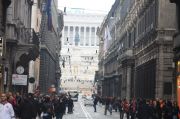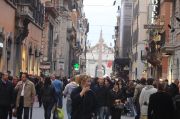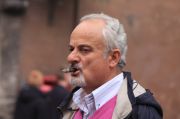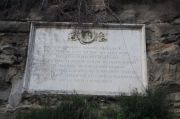| Roads are of fundamental importance to the development of our human beings, but today when we get more and more used to the modern highways, we are easily abandoning those ancient roads that are lead us from yesterday to today. |

Nov 2008 |
|
I did not know how many times I passed Via Flaminia in Rome without paying any particular attention to it, because I took it for granted that it had no difference as any other roads until a few days ago when I searched some information online for my travel report on Spoleto. I found that Via Flaminia is an ancient Roman Road with a long history of more than 2000 years, and then some interesting questions came to my mind: what's the situation of the road now? Is it still working as it was before? I was not totally convinced by the information that I got from the website, and I had to trust myself to find them out. A big plan was initiated, and I would like to explore the road and the major towns along it. The purposes of doing this are as simple as and old Chinese proverb saying that when you drink water, you should not forget the one who digged the well. And I also have a quite special perspective on travelling. To me travelling is more than just relaxation, it is a learning process. Sharing pictures and travel reports with dear friends here is a great fun for me, but my expectation from here does not end at sharing sheer information and experience. When I am travelling to a certain place, I am always putting it together with my home country. I know most of times it is not an easy job to find something new, but when you are put into new environment, you are more sensative than those who also got used to it. Being travellers, sensativity is our advantages for finding things new, which I believe is the meaning of travellings. Let me conclude with another Chinese philosophy: Beauty is everywhere, the key point is that whether you have the eyes to find it.
|
|
| Favourite spots: |
Wikipedia gives very detailed information about via Flaminia. It says that Via Flaminia took its after Gaius Flaminius, the Roman censor who built the road around 220 BC, that's why this road is also called the consular road. It run through the heartland of Italy, including the mountain areas in Umbria, Marche, leading from Rome to Rimini, indicating the strategic importance of which in connecting the Tyrrhennian sea and Adriatic sea. The total distance of the road is 210 Roman miles, 193 English miles, or 311km.
I know 310 km is nothing but a 4-hour drive today, but if we look at it back to 2000 years ago, it was definitely the biggest challenge for the entire humankind at that time. That's why the road becomes a miracle to me because it has survived a history almost as long as our own. You may still find via flaminia from the map of Italy, but the ancient road remains just the name and almost the whole part of which are replaced by the National Road SS3 (Strada Statale 3).
|
|
| What's really great: |
|
It does not mean the ancient consular road is already dead, there are still enormous extant relics that could be found along the road, which become invaluable resources for the local cities to promote tourism, in this sense the road still plays an important role in connecting the local towns along it with outside worlds as it used to be. In recent years, the economic performance of China has caught the eyes of the whole world, maybe people may want to know the weapons for achieving this great success, but China has own assessment, which concludes that if a country wants to become more advanced, it has to build the road first. I know there are something more than the road for the achievement of China now, but it does at least validate the importance of roads to the economy as well as the development of whole society. It is amazing that Romans already knew this secret more than 2000 years ago!!! I am wondering the mordern Chineses and the ancient Romans, who are smarter?
|
|
| Sights: |
|
My Chinese Story does not end there. With the rapid economic growth, a lot of cities in China are fond of building the so-called "image projects", which serve as tangile tools for those in power to show off their political performance. I find that almost every medieval town in Italy does have their own image projects too. The Italian image projects are more or less two things: main square ( usually hosts the municipal building) and the duomo or Cathederal. Therefore you will be more experienced next time when you travel around Italy, where to go and how to tell the elegance of the towns. If you want me to add something more, I have to say that Italian towns are almost all built on the top of the hill, good position and beautiful settings make great cities. You can not look at italian towns meanwhile neglecting their surroundings. The ancient Chineses strove for the so-called harmony of man with nature, but I see the this Chinese philophy from the Italian architecture.
|
|
| Accommodations: |
 |
 |
 |
 |
 |
 |
 |
 |
Via Corso, the background is Venice Square, Giambaldi Statue
 |
 |
I would like to list all the major places and the extant remains along Via Flaminia here, therefore you may have a clear idea about my route of travelling:
1. Piazza del Popolo and Monte Milvio
2. Civita Castellana (Pile di Augusto)
3. Otricoli
4. Narni ( ponte di Augusto)
5. San Gemini (Carsulae)
6. Aquasparta (Fonte Fonnaia)
7. Massa Martana
8.Bevagna
9. San Giovanni Profiamma
10. Foligno
11. Nocera Umbra
12. Gualdo Tadino
13. Fossato di Vico
14. Scheggia
15. Cagli
16. Gola d. Furlo
17. Fossombrone
18. Fano
19. Pesaro
20. Rimini
what I would like to do is to report to you the extant remains that are found along the roads, meanwhile exploring the nice towns it runs through or in the vicinity of the road, for example, Terni, Todi, Montefalco, Spello, Assisi, Perugia, Gubbio, Citta di Catello, Urbino.
But I would not be possible to give you such information as required by the reporting formality, for example, hangout, restraunts, you may find them easily
|
|
| Nightlife: |
 |
 |
 |
 |
 |
 |
 |
 |
Via Corso, the background is People's Square
 |
 |
Let me start with Via Corso, Ponte Milvio and a nearby town called Prima Porta.
Wikipedia says that Via Corso was the urban stretch of Via Flaminia. Its original name is Via Lata. For those who have seen Rome may not know where it is, but if you remind them of Piazza Spagna, Fonte Trevi, Pantheon, or even more easily, the shopping street, they may immediately remember where it is. Via Corso is the road in central Rome, leading from Piazza Venezia (Venice Square) to Piazza del Popolo. All the big places in Rome are either along it or within its walking vicinity, just to name a few, Navona Square, Colossem. It is one of the most crowded roads in Rome, and definitely the most prosperous part of Via Flaminia. You can use this road as the base to explore Rome, or if you like window shopping, it would be an ideal place to do that.
|
|
| Hangouts: |
 |
 |
 |
 |
 |
 |
 |
 |
Image of Italy, A Nation addictive to Cigar and Beers is decadent one, but that' what i see in Italy
 |
 |
All the scenic pictures in my report are about Milvian bridge (Ponte Milvio). The original bridge was built in 206 BC by Gaius Claudius Nero, the then consul, and was dedicated to the triuphant victory of Rome over Carthage in the second Punic War. But the current bridge as it stands was rebuilt in 115 BC on the basis of the old one. In 312, the famous battle "Battle of Milvian Bridge" broke out there between Constantine and Maxentius. After centuries, the bridge has made several big renovations.
At the entrance of the bridge, I am surprised to see the padlocks used by those people who are engaged and going to get married. This practice is also very popular in China too. But we call them "heart-to-heart" padlock, which means when the two padlocks are locked (phisically), our hearts will be together forever(spiritual). The bridge therefore is also called love bridge.
|
|
| Restaurants: |
 |
 |
 |
 |
 |
 |
 |
 |
the future of Italy, a childlike smile
 |
 |
The most striking thing is what I saw in the river. The water is quite muddy and rapid, I can not tell whether it has been like this since the ancient times or it has become this because of pollution. There are a lot of birds diving into the water suddenly for the food or just perching on an abandoned wood in the water. It seems to me that the river is not quite deep and going to dry up. The wood and birds on it brought me back to the scenes that I saw in the television homes are eating by the flood in Bangladesh and people are struggling for something to save their lives. Maybe one day our humankind's situation is really like what happens to the birds now, because of the global warming or the pollution!!!
It is a pity to see many miserable homelesses hanging around the bridge. The stinging smell and the staring eyes when you pass by make you quite nervous and uncomfortable.
|
|
| Other recommendations: |
 |
 |
 |
 |
 |
 |
 |
 |
Roman Inscription in Prima Porta, I do not understand, it's only for you
 |
 |
Prima Porta is the first town that I visited along via Flaminia. It is just at the outskirts of Rome. The name, literally first door, came from an arch of the aqueduct that brought water to the Villa of Livia, which formed over Via Flaminia a sort of gateway which travellers saw as the first indication of having reached Rome.
Prima Porta is famous for the the major discovery in 1863, a 2.04m high marble statute of Augustus Caesar at Villa of Livia of Prima Porta. The villa took the name after Livia Drusilla, Augustus's wife, who died and buried there.
The modern town is not interesting at all. Traffic and big Noises make it an unpleasant place to stay. The villa of Livia lies at a nice park with a big grassland, but it is quite small. I am a little disappointed at what I found there, drunken people, abandoned beer bottles, bad smell (because of Pissing), it is really a good place to see the decadent side of Italy.
|
|
Published on Monday November 17th, 2008
|
|
 Publish on Facebook
Publish on Facebook
|
Wed, Dec 03 2008 - 07:31 AM
 by davidx
The 5* grade is as much for the idea of a series based on an old road as for the report itself. As Jorge says, it opens up all sorts of ideas.
I think somebody younger than I would be better able to folow up the Roman roads in England but I hope somebody will! I suppose I cheated by reading your second one first but i shall now go to the third and I hope to keep in order. |
Thu, Nov 20 2008 - 01:46 PM
 by rangutan by rangutan
| Interesting "old-road" report. I got a bit disorientated in the report though, perhaps a sketch/map included as an image would help? Less spaces too? [4.0] |
Wed, Nov 19 2008 - 11:13 PM
 by gloriajames by gloriajames
This is the best amongst your reports! 5*
Cant wait to read your next :) |
Mon, Nov 17 2008 - 07:52 PM
 by aufgehts by aufgehts
| Yuliang, what a report! You have loads of information in it and a beautiful eye for the details. You certainly did your homework in writing this. Great job! :-) |
Mon, Nov 17 2008 - 12:32 PM
 by krisek by krisek
| Yuliang, very nice, personal and detailed report. I also do not feel very comfortable seeing many homeless people. I would not expect many homeless in Italy, though; in the country were family is sacred. Thank you for sharing. |
Mon, Nov 17 2008 - 04:21 AM
 by jorgesanchez by jorgesanchez
You gave me the idea to make on foot that Via Flaminia! You should come to Spain, we still have many Roman Vias, the most famous is Via de la Plata (Silver Road), made by the Romans to collect the silver in the Iberian Peninsula to take it to Rome. And for religious purposes, consider to make the Camino de Santiago (I have a report about this pilgrimage).
Good read. Very original subjet. Congratulations. |
| Information: |
| Login if you are a member, or sign up for a free membership to rate this report and to earn globo points! |
|

|
